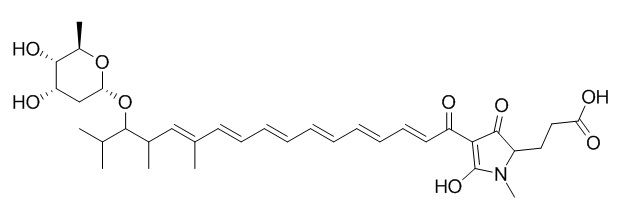Oleficin
Oleficin, a polyene antibiotic, it is active against Grampositive bacteria and has no effect upon the growth of fungi and yeasts.Oleficin has effects on mitochondrial functions can be explained on the basis of an increase of the inner membrane permeability as the consequence of the depletion of Mg2+ from mitochondria caused by the antibiotic. It could as an ionophore of Mg2+ in isolated rat liver mitochondria, preferentially inhibit growth of the yeast Saccharomyces cerevisiae on non-fermentable substrates.
Inquire / Order:
manager@chemfaces.com
Technical Inquiries:
service@chemfaces.com
Tel:
+86-27-84237783
Fax:
+86-27-84254680
Address:
1 Building, No. 83, CheCheng Rd., Wuhan Economic and Technological Development Zone, Wuhan, Hubei 430056, PRC
Providing storage is as stated on the product vial and the vial is kept tightly sealed, the product can be stored for up to
24 months(2-8C).
Wherever possible, you should prepare and use solutions on the same day. However, if you need to make up stock solutions in advance, we recommend that you store the solution as aliquots in tightly sealed vials at -20C. Generally, these will be useable for up to two weeks. Before use, and prior to opening the vial we recommend that you allow your product to equilibrate to room temperature for at least 1 hour.
Need more advice on solubility, usage and handling? Please email to: service@chemfaces.com
The packaging of the product may have turned upside down during transportation, resulting in the natural compounds adhering to the neck or cap of the vial. take the vial out of its packaging and gently shake to let the compounds fall to the bottom of the vial. for liquid products, centrifuge at 200-500 RPM to gather the liquid at the bottom of the vial. try to avoid loss or contamination during handling.
Heliyon.2022, 8(12):e12031.
Food Chem Toxicol.2020, 135:110863
J Bone Miner Res.2017, 32(12):2415-2430
Jour. of Stored Pro & Postharvest Res.2016, 7(3):32-36
J Pharm Biomed Anal.2024, 251:116444.
Molecules.2018, 23(7):E1817
Oxid Med Cell Longev.2022, 2022:5888636.
Food Chem.2021, 377:131976.
Eur J Pharmacol.2023, 960:176121.
Fitoterapia.2024, 175:105958.
Related and Featured Products
Biochim Biophys Acta. 1982 Dec 30;721(4):349-56.
Ionophores and intact cells. II. Oleficin acts on mitochondria and induces disintegration of the mitochondrial genome in yeast Saccharomyces cerevisiae.[Pubmed:
6818995]
METHODS AND RESULTS:
The non-macrolid polyene antibiotic Oleficin, which has been shown to function as an ionophore of Mg2+ in isolated rat liver mitochondria, preferentially inhibited growth of the yeast Saccharomyces cerevisiae on non-fermentable substrates. It uncoupled and inhibited respiration of intact cells and converted both growing and resting cells into respiration-deficient mutants. The mutants arose as a result of fragmentation of the mitochondrial genome. Another antibiotic known to be an ionophore of divalent cations, A23187, also selectively inhibited growth of the yeast on non-fermentable substrates, but did not produce the respiration-deficient mutants, neither antibiotic inhibited the energy-dependent uptake of divalent cations by yeast cells nor opened the plasma membrane for these cations.
CONCLUSIONS:
The results indicate that in Saccharomyces cerevisiae both Oleficin and A23187 preferentially affected the mitochondrial membrane without acting as ionophores in the plasma membrane.
J Antibiot (Tokyo). 1971 May;24(5):277-82.
Antibiotics produced by Streptomyces. 8. A new polyenic antibiotic, oleficin, exhibiting antibacterial activity[Reference:
WebLink]
A new polyenic antibiotic has been isolated from a strain A-461, related to Streptomyces parvulus which is described in this paper.
METHODS AND RESULTS:
Oleficin was obtained as a dark red powder by methanolic extraction of the filtered mycelium, followed by evaporation of the solvent and re-extraction into ethyl acetate, evaporation, precipitation with petroleum ether and chromatography on alumina. Its ultraviolet and visible spectra suggest the possible presence in its molecule of two chromophores, one of which is a polyene-like.
CONCLUSIONS:
It is active against Grampositive bacteria and has no effect upon the growth of fungi and yeasts.
J Antibiot (Tokyo). 1980 May;33(5):494-500.
Interaction of oleficin with the inner membrane of rat liver mitochondria.[Pubmed:
6448831]
The effects of Oleficin, a polyene antibiotic of the nonmacrolide type, on isolated rat liver mitochondria were studied. Oleficin at a concentration of about 10 nmoles/mg protein increases both the rate of state 4 respiration and the "basal" ATPase activity of mitochondria. In contrast to this it inhibits the rate of both state 3 and uncoupled respiration and the DNP-stimulated ATPase activity.
METHODS AND RESULTS:
These inhibitions can be prevented by low concentrations (2 approximately 5 mM) of magnesium ions. Oleficin induces a high amplitude swelling of non-respiring mitochondria in the isoosmotic nitrate and chloride solutions of K+, Na+, Tris+, Tea+ or Mg2+. In contrast to that it does not induce swelling of mitochondria treated with ruthenium red in isoosmotic calcium acetate. Indirect evidence suggests that Oleficin increases also the proton permeability of the inner membrane. The swelling observed in the isoosmotic solutions of monovalent cations can be prevented by low concentration (2 approximately 5 mM) of Mg2+. In the presence of the antibiotic Mg2+ and Ca2+ but not K+ and Na+, are transferred from an aqueous phase into a butanol-toluene bulk phase. Oleficin depletes Mg2+ and Ca2+ from mitochondria in a concentration dependent manner. Complete depletion of Mg2+ occurs only in the presence of EDTA, while that of Ca2+ does not need the chelator.
CONCLUSIONS:
It is concluded that the effects of Oleficin on mitochondrial functions can be explained on the basis of an increase of the inner membrane permeability as the consequence of the depletion of Mg2+ from mitochondria caused by the antibiotic.



